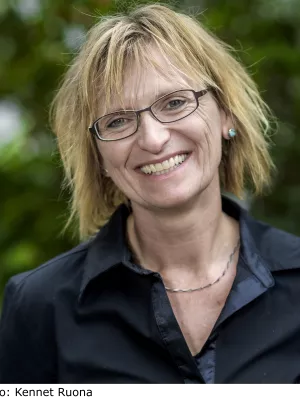
Natascha Kljun
Professor

Monitoring boreal forest biomass and carbon storage change by integrating airborne laser scanning, biometry and eddy covariance data
Författare
Summary, in English
This study presents a comparison and integration of three methods commonly used to estimate the amount of forest ecosystem carbon (C) available for storage. In particular, we examine the representation of living above- and below-ground biomass change (net accumulation) using plot-level biometry and repeat airborne laser scanning (ALS) of three dimensional forest plot structure. These are compared with cumulative net CO2 fluxes (net ecosystem production, NEP) from eddy covariance (EC) over a six-year period within a jack pine chronosequence of four stands (~ 94, 30, 14 and 3 years since establishment from 2005) located in central Saskatchewan, Canada. Combining the results of the two methods yield valuable observations on the partitioning of C within ecosystems. Subtracting total living biomass C accumulation from NEP results in a residual that represents change in soil and litter C storage. When plotted against time for the stands investigated, the curve produced is analogous to the soil C dynamics described in Covington (1981). Here, ALS biomass accumulation exceeds EC-based NEP measured in young stands, with the residual declining with age as stands regenerate and litter decomposition stabilizes. During the 50–70 year age-period, NEP and live biomass accumulation come into balance, with the soil and litter pools of stands 70–100 years post-disturbance becoming a net store of C. Biomass accumulation was greater in 2008–2011 compared to 2005–2008, with the smallest increase in the 94-year-old “old jack pine” stand and greatest in the 14-year-old “harvested jack pine 1994” stand, with values of 1.4 (± 3.2) tC ha− 1 and 12.0 (± 1.6) tC ha− 1, respectively. The efficiency with which CO2 was stored in accumulated biomass was lowest in the youngest and oldest stands, but peaked during rapid regeneration following harvest (14-year-old stand). The analysis highlights that the primary source of uncertainty in the data integration workflow is in the calculation of biomass expansion factors, and this aspect of the workflow needs to be implemented with caution to avoid large error propagations. We suggest that the adoption of integrated ALS, in situ and atmospheric flux monitoring frameworks is needed to improve spatio-temporal partitioning of C balance components at sub-decadal scale within rapidly changing forest ecosystems and for use in national carbon accounting programs.
Publiceringsår
2016-08-01
Språk
Engelska
Sidor
82-95
Publikation/Tidskrift/Serie
Remote Sensing of Environment
Volym
181
Dokumenttyp
Artikel i tidskrift
Förlag
Elsevier
Ämne
- Agricultural Science, Forestry and Fisheries
- Climate Research
Nyckelord
- Net ecosystem production (NEP)
- Gross primary production (GPP)
- Stand growth
- Change detection
- Airborne laser scanning
- Multi-temporal LiDAR
- Jack pine chronosequence
- Boreal forest
- Carbon balance
- Monitoring framework
Status
Published
ISBN/ISSN/Övrigt
- ISSN: 0034-4257